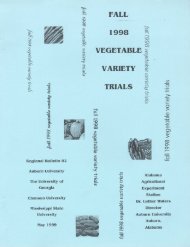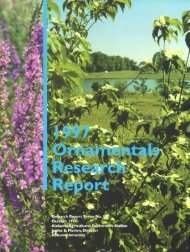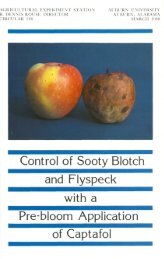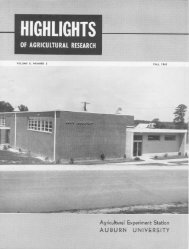MARKETING CHRISTMAS TREES - Auburn University Repository
MARKETING CHRISTMAS TREES - Auburn University Repository
MARKETING CHRISTMAS TREES - Auburn University Repository
You also want an ePaper? Increase the reach of your titles
YUMPU automatically turns print PDFs into web optimized ePapers that Google loves.
4 ALABAMA AGRICULTURAL EXPERIMENT STATION<br />
tic production in 1947 and 12 per cent in 1955. On the other<br />
hand, Virginia and other southern pines accounted for about 4<br />
per cent of the production in 1947 and around 2 per cent in 1955.<br />
Thus, it appears that some southern trees are gaining in the total<br />
Christmas tree market whereas others are losing.<br />
The South 3 , with about a fourth of the total U.S. population, is<br />
furnishing no more than about an eighth of the Nation's total tree<br />
production, since not all red cedars are produced in this section.<br />
This figure includes production of a number of miscellaneous<br />
species.<br />
The difference between southern production and southern use<br />
is supplied by imports from Canadian provinces and from various<br />
northern states. For instance, it was estimated that Texas and<br />
Oklahoma received from Montana around three-fourths million<br />
trees in 1954 and again in 1955 (4). Also, it is reported that New<br />
England trees supply two-thirds of the New Orleans market, half<br />
of the Washington D.C. market, 4 and 15 per cent of the Atlanta<br />
market (2).<br />
This situation prevails despite production advantages and marketing<br />
opportunities of the South. "Christmas trees can be grown<br />
in the South in a much shorter time and at less cost than in other<br />
regions. As a consequence of long growing season and plentiful<br />
rainfall trees develop and grow rapidly. Relatively mild weather<br />
during the harvesting and marketing season creates added advantages<br />
for the production of Christmas trees in the South. In the<br />
northern United States and Canada, seasonal severe weather and<br />
deep snows frequently hamper harvesting and handling of Christmas<br />
trees. If they are harvested far in advance, treated to reduce<br />
transpiration, and stored until the shipping season, then cost goes<br />
up" (3). In addition to these advantages, the supply of labor is<br />
relatively high and wage rates are relatively low in the South.<br />
Part of the reason for the current failure of the South to produce<br />
and supply most of its own Christmas trees must be in the<br />
market place. To find out more about this question, the study<br />
reported herein was developed. Its principal objectives were, in<br />
general, to determine kind, size, and quality of Christmas trees<br />
marketed, methods of treating and handling trees, variations in<br />
The South, as used in this study, includes Texas, Oklahoma, Arkansas, Louisiana,<br />
Mississippi, Alabama, Georgia, Florida, South Carolina, North Carolina,<br />
Tennessee, Kentucky, and Virginia.<br />
Washington, D.C., while not in the South as defined above, borders Virginia.
















